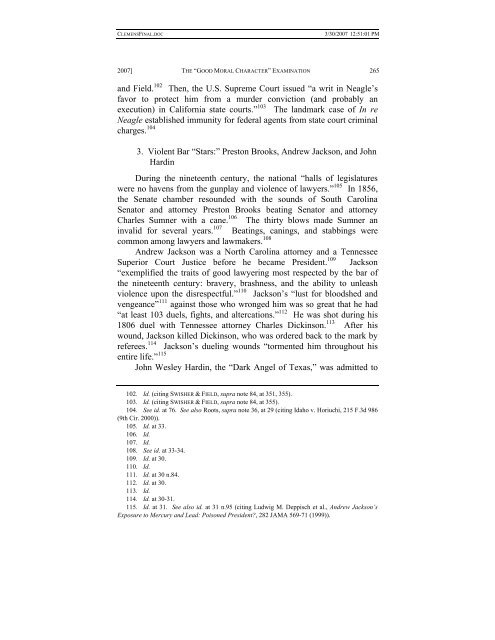Facing the Klieg Lights: Understanding the "Good Moral Character"
Facing the Klieg Lights: Understanding the "Good Moral Character"
Facing the Klieg Lights: Understanding the "Good Moral Character"
You also want an ePaper? Increase the reach of your titles
YUMPU automatically turns print PDFs into web optimized ePapers that Google loves.
CLEMENSFINAL.DOC<br />
3/30/2007 12:51:01 PM<br />
2007] THE “GOOD MORAL CHARACTER” EXAMINATION 265<br />
and Field. 102 Then, <strong>the</strong> U.S. Supreme Court issued “a writ in Neagle’s<br />
favor to protect him from a murder conviction (and probably an<br />
execution) in California state courts.” 103 The landmark case of In re<br />
Neagle established immunity for federal agents from state court criminal<br />
charges. 104<br />
3. Violent Bar “Stars:” Preston Brooks, Andrew Jackson, and John<br />
Hardin<br />
During <strong>the</strong> nineteenth century, <strong>the</strong> national “halls of legislatures<br />
were no havens from <strong>the</strong> gunplay and violence of lawyers.” 105 In 1856,<br />
<strong>the</strong> Senate chamber resounded with <strong>the</strong> sounds of South Carolina<br />
Senator and attorney Preston Brooks beating Senator and attorney<br />
Charles Sumner with a cane. 106 The thirty blows made Sumner an<br />
invalid for several years. 107 Beatings, canings, and stabbings were<br />
common among lawyers and lawmakers. 108<br />
Andrew Jackson was a North Carolina attorney and a Tennessee<br />
Superior Court Justice before he became President. 109 Jackson<br />
“exemplified <strong>the</strong> traits of good lawyering most respected by <strong>the</strong> bar of<br />
<strong>the</strong> nineteenth century: bravery, brashness, and <strong>the</strong> ability to unleash<br />
violence upon <strong>the</strong> disrespectful.” 110 Jackson’s “lust for bloodshed and<br />
vengeance” 111 against those who wronged him was so great that he had<br />
“at least 103 duels, fights, and altercations.” 112 He was shot during his<br />
1806 duel with Tennessee attorney Charles Dickinson. 113 After his<br />
wound, Jackson killed Dickinson, who was ordered back to <strong>the</strong> mark by<br />
referees. 114 Jackson’s dueling wounds “tormented him throughout his<br />
entire life.” 115<br />
John Wesley Hardin, <strong>the</strong> “Dark Angel of Texas,” was admitted to<br />
102. Id. (citing SWISHER & FIELD, supra note 84, at 351, 355).<br />
103. Id. (citing SWISHER & FIELD, supra note 84, at 355).<br />
104. See id. at 76. See also Roots, supra note 36, at 29 (citing Idaho v. Horiuchi, 215 F.3d 986<br />
(9th Cir. 2000)).<br />
105. Id. at 33.<br />
106. Id.<br />
107. Id.<br />
108. See id. at 33-34.<br />
109. Id. at 30.<br />
110. Id.<br />
111. Id. at 30 n.84.<br />
112. Id. at 30.<br />
113. Id.<br />
114. Id. at 30-31.<br />
115. Id. at 31. See also id. at 31 n.95 (citing Ludwig M. Deppisch et al., Andrew Jackson’s<br />
Exposure to Mercury and Lead: Poisoned President?, 282 JAMA 569-71 (1999)).
















